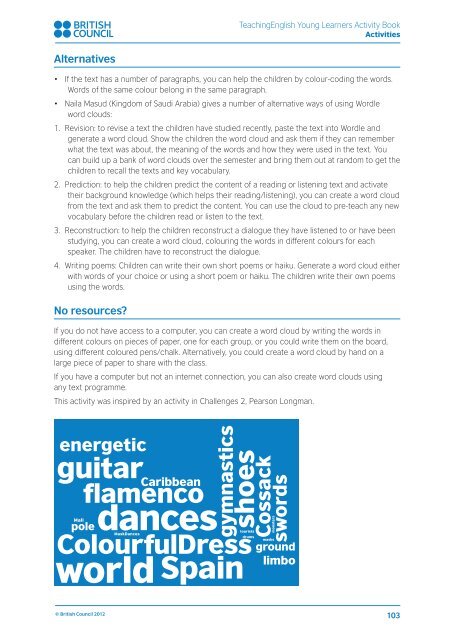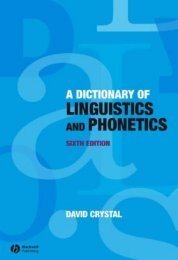url?sa=t&source=web&cd=3&ved=0CC0QFjAC&url=http://www.teachingenglish.org.uk/sites/teacheng/files/B369-Young-Learners-Activity-Book_v10
url?sa=t&source=web&cd=3&ved=0CC0QFjAC&url=http://www.teachingenglish.org.uk/sites/teacheng/files/B369-Young-Learners-Activity-Book_v10
url?sa=t&source=web&cd=3&ved=0CC0QFjAC&url=http://www.teachingenglish.org.uk/sites/teacheng/files/B369-Young-Learners-Activity-Book_v10
Create successful ePaper yourself
Turn your PDF publications into a flip-book with our unique Google optimized e-Paper software.
TeachingEnglish <strong>Young</strong> <strong>Learners</strong> <strong>Activity</strong> <strong>Book</strong><br />
Activities<br />
Alternatives<br />
• If the text has a number of paragraphs, you can help the children by colour-coding the words.<br />
Words of the same colour belong in the same paragraph.<br />
• Naila Masud (Kingdom of Saudi Arabia) gives a number of alternative ways of using Wordle<br />
word clouds:<br />
1. Revision: to revise a text the children have studied recently, paste the text into Wordle and<br />
generate a word cloud. Show the children the word cloud and ask them if they can remember<br />
what the text was about, the meaning of the words and how they were used in the text. You<br />
can build up a bank of word clouds over the semester and bring them out at random to get the<br />
children to recall the texts and key vocabulary.<br />
2. Prediction: to help the children predict the content of a reading or listening text and activate<br />
their background knowledge (which helps their reading/listening), you can create a word cloud<br />
from the text and ask them to predict the content. You can use the cloud to pre-teach any new<br />
vocabulary before the children read or listen to the text.<br />
3. Reconstruction: to help the children reconstruct a dialogue they have listened to or have been<br />
studying, you can create a word cloud, colouring the words in different colours for each<br />
speaker. The children have to reconstruct the dialogue.<br />
4. Writing poems: Children can write their own short poems or haiku. Generate a word cloud either<br />
with words of your choice or using a short poem or haiku. The children write their own poems<br />
using the words.<br />
No resources?<br />
If you do not have access to a computer, you can create a word cloud by writing the words in<br />
different colours on pieces of paper, one for each group, or you could write them on the board,<br />
using different coloured pens/chalk. Alternatively, you could create a word cloud by hand on a<br />
large piece of paper to share with the class.<br />
If you have a computer but not an internet connection, you can also create word clouds using<br />
any text programme.<br />
This activity was inspired by an activity in Challenges 2, Pearson Longman.<br />
energetic<br />
guitar<br />
Mali<br />
Caribbean<br />
flamenco<br />
poledances<br />
gymnastics<br />
shoes<br />
MaskDances<br />
ColourfulDress<br />
world Spain<br />
Cossack<br />
monsters<br />
swords<br />
tourists<br />
drums<br />
masks<br />
ground<br />
limbo<br />
© British Council 2012<br />
103





